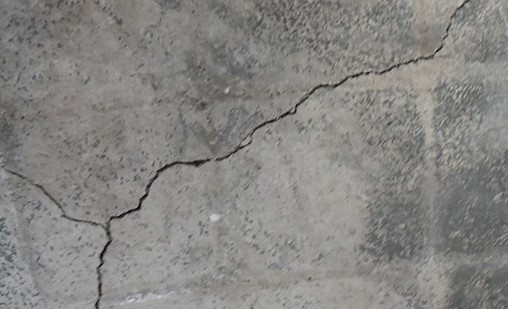Pyrite is a mineral that homeowners should be wary of when it comes to their garage and basement. If left unchecked, it can cause significant damage to the foundation of the structure due to its potential to swell and crack the concrete slab over time. In this article, we will explore the effects of pyrite in backfill and how it can affect your garage or basement concrete slab.
What is Pyrite and Pyrrhotite?
How do they Affect Building Foundations?
Pyrite and pyrrhotite are iron sulphides that are found in nature. They are often present in the soil around homes and buildings. While they may seem harmless, they can cause serious issues for building foundations if left untreated.
When pyrite or pyrrhotite are present in the backfill material used to create a foundation or a floor slab, they can cause significant damage over time. This is due to a chemical reaction that occurs between the iron sulphides and moisture. As water enters the backfill and reacts with the pyrite or pyrrhotite, it causes the minerals to oxidize and expand. This can ultimately lead to cracks in the slab or foundation and/or have a lateral push on the foundation putting the structure at risk of severe damage.
What is the Presence of Pyrite in Backfill Material?
The presence of pyrite in backfill material can have significant implications for the homeowner, as it can lead to a pyrite problem that worsens over time. The volume of the fill, the potential for swelling, and the swelling pressure all contribute to the effects of pyrite in the backfill. The swelling potential of the backfill material containing pyrite is increased when the backfill is made of crushed stone or other high-porosity material that can absorb water more easily.
What is I.P.P.G. and How Does it Relate to Pyrite?
I.P.P.G. stands for Index de Potentiel de Gonflement des Sol (Swelling Potential Index of Soil). It is a measure of the swelling potential of soil and backfill. I.P.P.G. values are used to determine whether the backfill used in construction could potentially cause cracking and other damage to the building. If the I.P.P.G. value is high, it indicates that there is a high potential for swelling and cracking in the future, especially if pyrite or pyrrhotite are present in the backfill. Here are the ratio established by the Protocole CTQ-M200.
|
IPPG |
Importance du potentiel de gonflement |
|
(0=nul) 1 à 10 |
négligeable |
|
11 à 20 |
faible |
|
21 à 40 |
faible à moyen |
|
41 à 60 |
moyen à élevé |
|
61 à 80 |
élevé |
|
81 à 100 |
extrêmement élevé |
What is the Swelling Potential of the Backfill Material Containing Pyrite?
There is a significant potential for swelling in backfill material containing pyrite. As the backfill absorbs water, the pyrite begins to oxidize, leading to the formation of sulphuric acid and the consequent swelling of the backfill material. The swelling pressure can cause significant damage to the foundation or floor slab over time. Bear in mind that having a high IPPG does not mean that you will automatically have swelling. The main goal is to keep the water away from the foundation and the backfill so if you have good drainage around your home you could avoid the problem all together. Another thing to keep in mind is the water table under your home. From years to years it moves up and down and could potentially get close enough to your home to activate the oxydation of the pyrite.
What are the Problems Associated with Pyrite?
What is the Chemical Reaction that Occurs in the Presence of Pyrite?
The chemical reaction that occurs in the presence of pyrite is known as oxidation. When exposed to water and air, the iron sulphide within the pyrite oxidizes to form iron oxide, which can cause the backfill material to swell and exert pressure on the concrete slab or foundation of the structure. Gypsum crystals can also form within the backfill, contributing to the swelling and further damaging the foundation or slab.
How to Perform a Pyrite Test?
What Materials are Used in the Pyrite Test?
A pyrite test involves the use of a device called a pyrite tester, which is used to determine whether pyrite is present in the backfill material around the foundation or floor slab. The tester consists of a small glass container, a ball bearing, and a solution of sodium hydroxide.
What are the Steps to Perform a Pyrite Test?
The steps involved in performing a pyrite test are relatively simple. First, a sample of the backfill material is taken from around the foundation or floor slab. The sample is then placed in the glass container along with the ball bearing and the sodium hydroxide solution. The container is sealed and shaken to mix the solution with the backfill material. After a few minutes, the container is examined to see if any bubbles have formed. If bubbles are present, it indicates that pyrite or pyrrhotite are present in the backfill material.
What Does the Pyrite Test Results Indicate?
If the pyrite test indicates that pyrite or pyrrhotite are present in the backfill material, it is a sign that the homeowner may be at risk of significant structural damage in the future. It is important to take action to contain the pyrite as soon as possible to prevent further damage to the foundation or floor slab.
Effects of Pyrite on Your Basement or Garage Concrete Slab
What are the Common Signs of a Pyrite Problem?
The signs of a pyrite problem in your basement or garage can vary, but some of the most common signs include cracks in the slab more specifically crack in a star shape form with a vertical push from it’s center point, bulging or swelling of the floor, and water infiltration. In some cases, the foundation walls may also be affected, which can lead to further structural damage.
How Does Pyrite in Backfill Material Affect the Concrete Slab?
Pyrite in backfill material can affect the concrete slab in a number of ways. As the backfill material swells and expands due to the chemical reaction caused by the pyrite, the slab can be pushed upward, leading to bulging and cracking. Over time, this can cause significant damage to the structure and compromise its overall structural integrity.
Why Does Pyrite Cause Cracks in the Slab?
Pyrite can cause cracks in the slab due to the swelling pressure caused by the chemical reaction. As the backfill material expands and pushes upward, the slab can become damaged and eventually crack. The cracks may start small, but can grow over time, leading to significant structural damage if left untreated.
How to Deal with Pyrite in Your Basement or Garage Concrete Slab?
What is the Process to Contain Pyrite in the Backfill Material?
The process to contain pyrite in the backfill material involves removing the affected backfill and replacing it with clean, high-quality backfill material that is not contaminated with pyrite or other harmful substances. This process can be time-consuming and costly, but it is necessary to ensure that the structure is safe and stable over the long term. In Quebec, backfill that is replaced today or found in a new construction will have a DB certification that garantee’s that there is no pyrite in it.
What Should a Homeowner Do When Pyrite is Found?
If pyrite is found in the backfill material around the foundation or floor of a homeowner’s structure, it is important to take action as soon as possible. Contacting a professional contractor or engineer is recommended to perform an assessment and determine the best course of action. This may involve removing the affected backfill and replacing it with clean, high-quality backfill material, or other remedial measures that can help contain the pyrite and prevent further damage to the structure.
What Are the Options When a Concrete Slab Is Already Damaged Due to Pyrite?
If a concrete slab is already damaged due to pyrite, there are a few options available to homeowners. One option is to have the damaged slab removed and replaced with a new slab that is not contaminated with pyrite. Another option is to reinforce the damaged slab with additional framing and support to help prevent further damage.
FAQs About Pyrite in Backfill
Q: What is the south shore of Montreal Pyrite Problem?
The south shore of Montreal Pyrite Problem refers to the significant issues caused by pyrite in backfill material used in construction in different cities south shore of Montreal. Certain cities like Brossard, Delson, Saint-Bruno-de-Montarville, Saint-Basile-le-Grand, Sainte-Julie, Beloeil. Chambly, Carignan etc. are know to have houses built with backfills containing pyrite so it is imperitive to have it tested before buying a house, it’s a normal process of due diligence.
Q: What is the pyrite problem?
A: The pyrite problem, also known as the pyrite or pyrrhotite problem, refers to the issue where homes and buildings built on land with pyrite or pyrrhotite backfill experience damage to their concrete foundations.
Q: What is backfill?
A: Backfill are rocks used to fill the space under the concrete slab. Because the space is limited, if the backfill swells, it will could crack the slab and cause major structural problems to the home.
Q: What is IPPG?
A: IPPG stands for the Inspection des Pyrrhotites et des Pyrites dans les Granulats, which is a petrographic analysis used to determine if the aggregate used in construction contains pyrrhotite or pyrite.
Q: How does pyrite in backfill affect a basement or garage concrete slab?
A: Pyrite in backfill can cause the basement or garage concrete slab to heave, leading to cracks in the concrete and other damage. In certain conditions, exposure to water and oxygen can increase the volume of pyrite, causing it to disintegrate the concrete and cause significant damage to your property.
Q: What are the signs of a pyrite problem in a basement slab?
A: Signs of a pyrite problem in a basement slab include heave, cracking, and buckling of the concrete, as well as visible staining and odors.
Q: Can a pyrite problem be fixed?
A: Yes, a pyrite problem can be fixed, but it often requires the removal of the concrete slab and the backfill underneath it. This can involve the demolition and reconstruction of the affected area, which can be costly and time-consuming.
Q: How can I prevent a pyrite problem in my basement or garage slab?
A: The best way to prevent a pyrite problem is to ensure that the backfill used in construction does not contain pyrite or pyrrhotite. This can be determined through a multitest analysis or IPPG analysis before construction begins. But if you already have pyrite in your house, there’s only one way, keep the water away. Make sure you’re house is properly drained.
Q: Can I sell my home if it has a pyrite problem?
A: Yes, you can sell your home if it has a pyrite problem, but you must disclose the issue to potential buyers. It is recommended that you work with a qualified inspector or engineer to determine the severity of the problem before putting your home on the market.
Q: Can a finished basement or garage be affected by a pyrite problem?
A: Yes, a finished basement or garage can be affected by a pyrite problem. In fact, it may be more difficult to detect the issue in finished areas where the concrete is covered by flooring or other materials.
Q: Is a pyrite problem common in certain areas?
A: Pyrite problems are more common in certain areas, particularly in Quebec, Canada, in the Island of Montreal and surrounding. This is due to the high concentration of naturally occurring pyrite in the area, which can be present in backfill materials.

